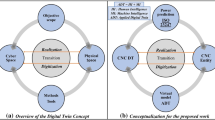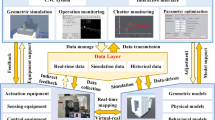Abstract
Manufacturers can use a digital twin to obtain a better understanding of the performance and operational circumstances of a manufacturing asset through near real-time data collected from the asset and make proactive decisions about its optimal operation. Due to its great machining efficiency and good finish quality, grinding is one of the most used precision machining techniques. The vertical double side grinding machine does the necessary work while connected to the PLC program, and we established a methodology for process behavior prediction utilizing a digital twin approach in this paper. The proposed method creates a model of the grinding machine and calculates the grinding force and motor current value using data from sensors, physical models, and system operation. Results from simulations demonstrate how models and communication should be connected. The digital model was established to exactly match the operation of the physical system. Comparison between predicted result obtained from the proposed digital twin model and experiment, revealed a good agreement between proposed model and practice, indicating therefore that the model may be suitable for industrial applications further.
Access this chapter
Tax calculation will be finalised at checkout
Purchases are for personal use only
Similar content being viewed by others
References
Uhlemann, T.H.J.: The digital twin: demonstrating the potential of real time data acquisition in production systems. Proc. Manuf. 9, 113–120 (2017)
Papetti, A.: A method to improve workers’ well-being toward human-centered connected factories. J. Comput. Des. Eng. 7(5), 630–643 (2020)
Rosen, R.: About the importance of autonomy and digital twins for the future of manufacturing. IFAC-PapersOnLine 48(3), 567–572 (2015)
Lim, K.Y.H.: A state-of-the-art survey of digital twin: Techniques, engineering product lifecycle management and business innovation perspectives. J. Intell. Manuf. 31, 1–25 (2019)
Hochhalter, J.D.: Coupling damage-sensing particles to the digital twin concept
Qi, Q.: Digital twin and big data towards smart manufacturing and industry 4.0: 360 degree comparison. IEEE Access (6), 3585–3593 (2018)
Tao, F.: Digital twin-driven product design, manufacturing, and service with big data. Int. J. Adv. Manuf. Technol. 94(9), 3563–3576 (2018)
Swisher, J.R.: A survey of recent advances in discrete input parameter discrete-event simulation optimization. IIE Trans. 36(6), 591–600 (2004)
Barlas, P.: Automation of input data to discrete event simulation for manufacturing: a review. Int. J. Modell. Simulat. Scient. Comput. 7(1), 163 (2016)
Author information
Authors and Affiliations
Corresponding author
Editor information
Editors and Affiliations
Rights and permissions
Copyright information
© 2023 The Author(s), under exclusive license to Springer Nature Switzerland AG
About this paper
Cite this paper
Qi, B., Park, H. (2023). A DT-Based System for Predicting Process Behavior. In: Valle, M., et al. Advances in System-Integrated Intelligence. SYSINT 2022. Lecture Notes in Networks and Systems, vol 546. Springer, Cham. https://doi.org/10.1007/978-3-031-16281-7_24
Download citation
DOI: https://doi.org/10.1007/978-3-031-16281-7_24
Published:
Publisher Name: Springer, Cham
Print ISBN: 978-3-031-16280-0
Online ISBN: 978-3-031-16281-7
eBook Packages: EngineeringEngineering (R0)




